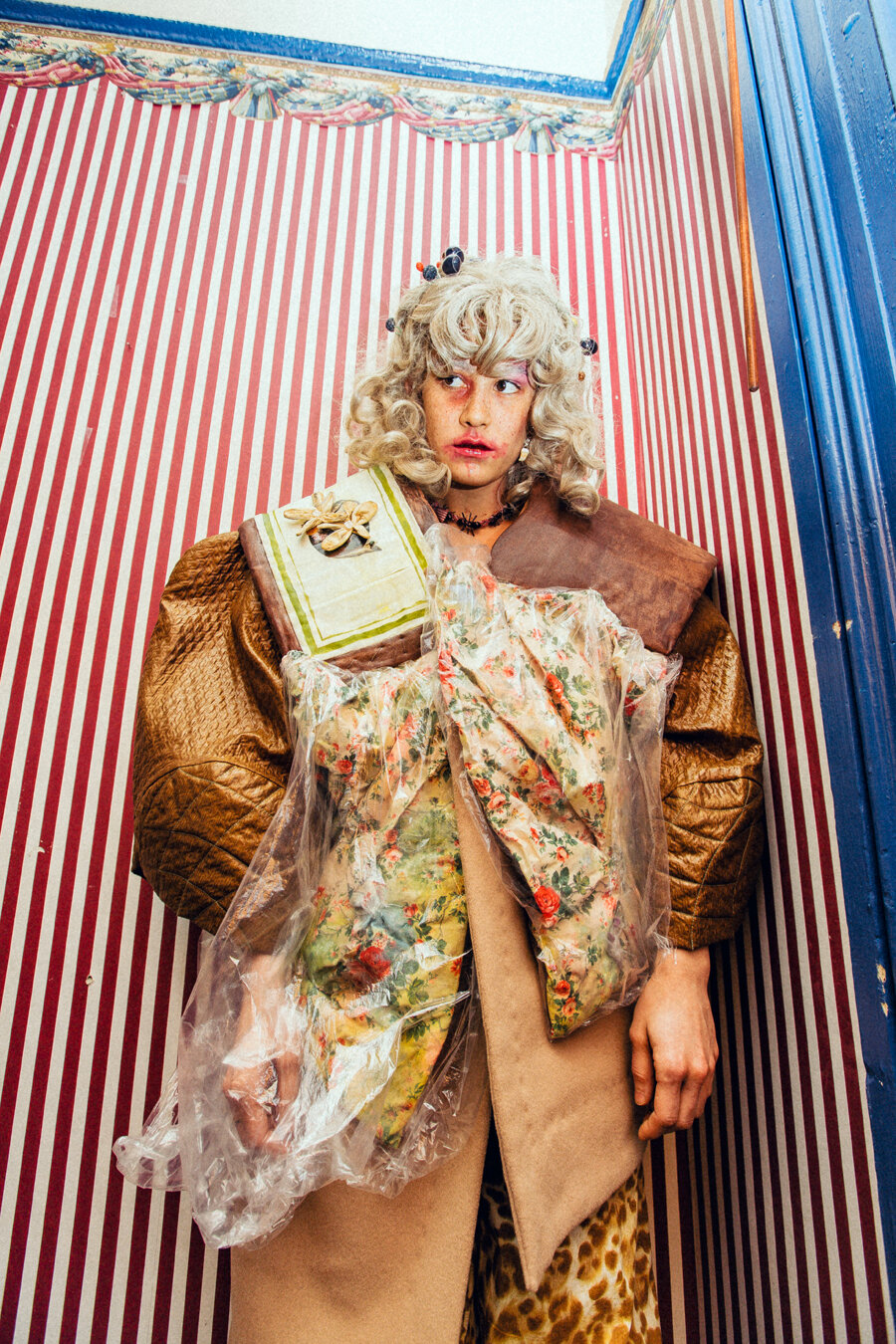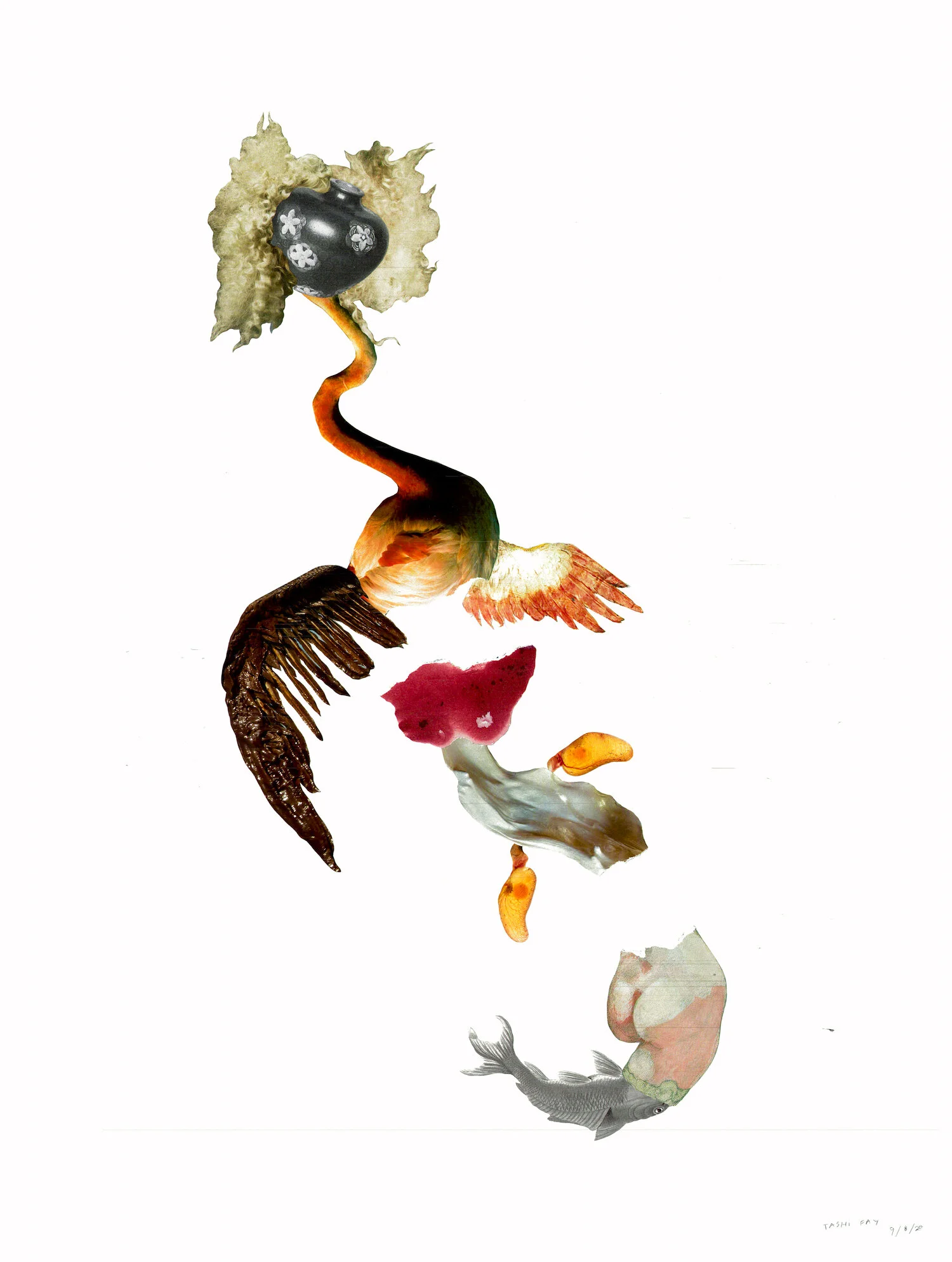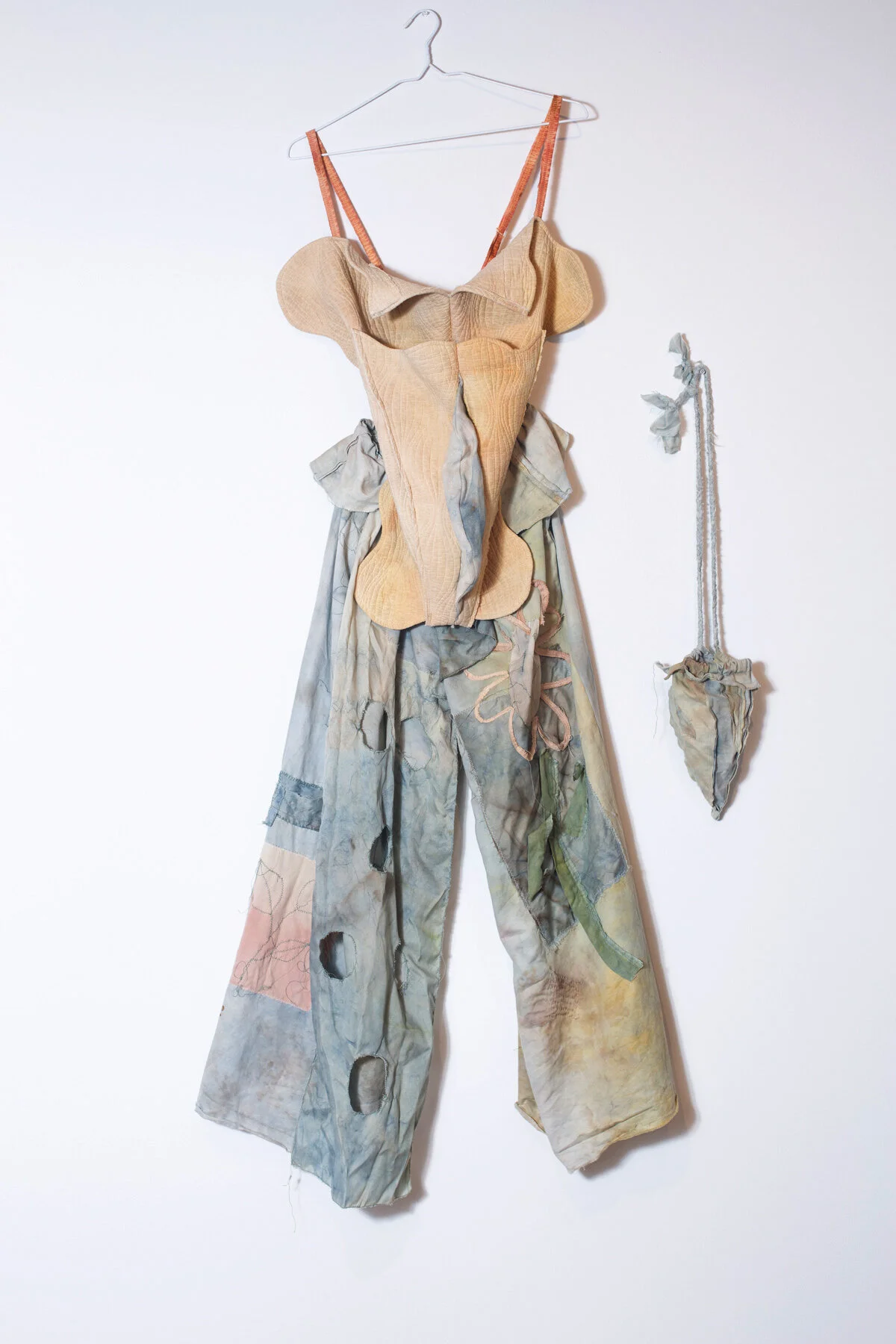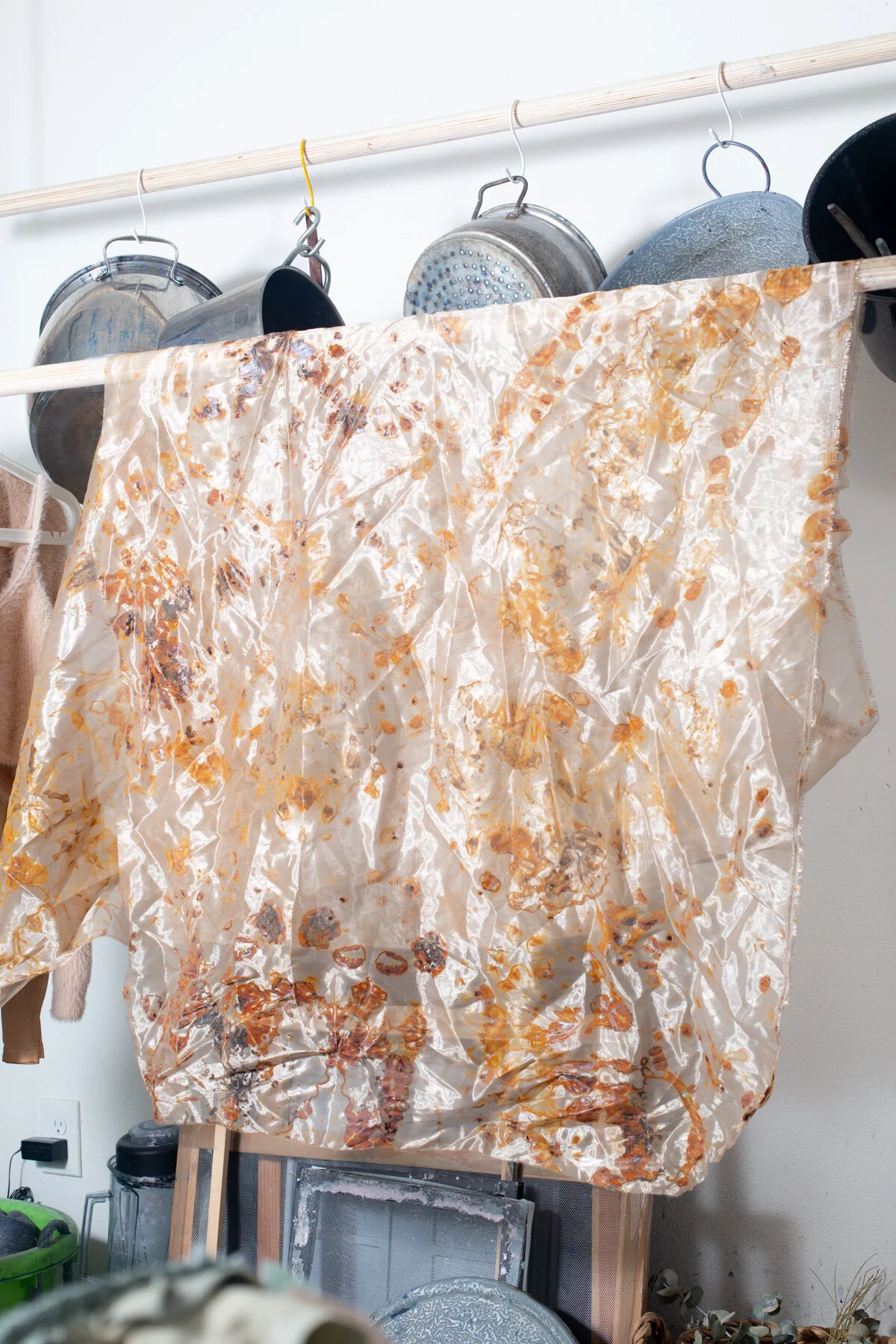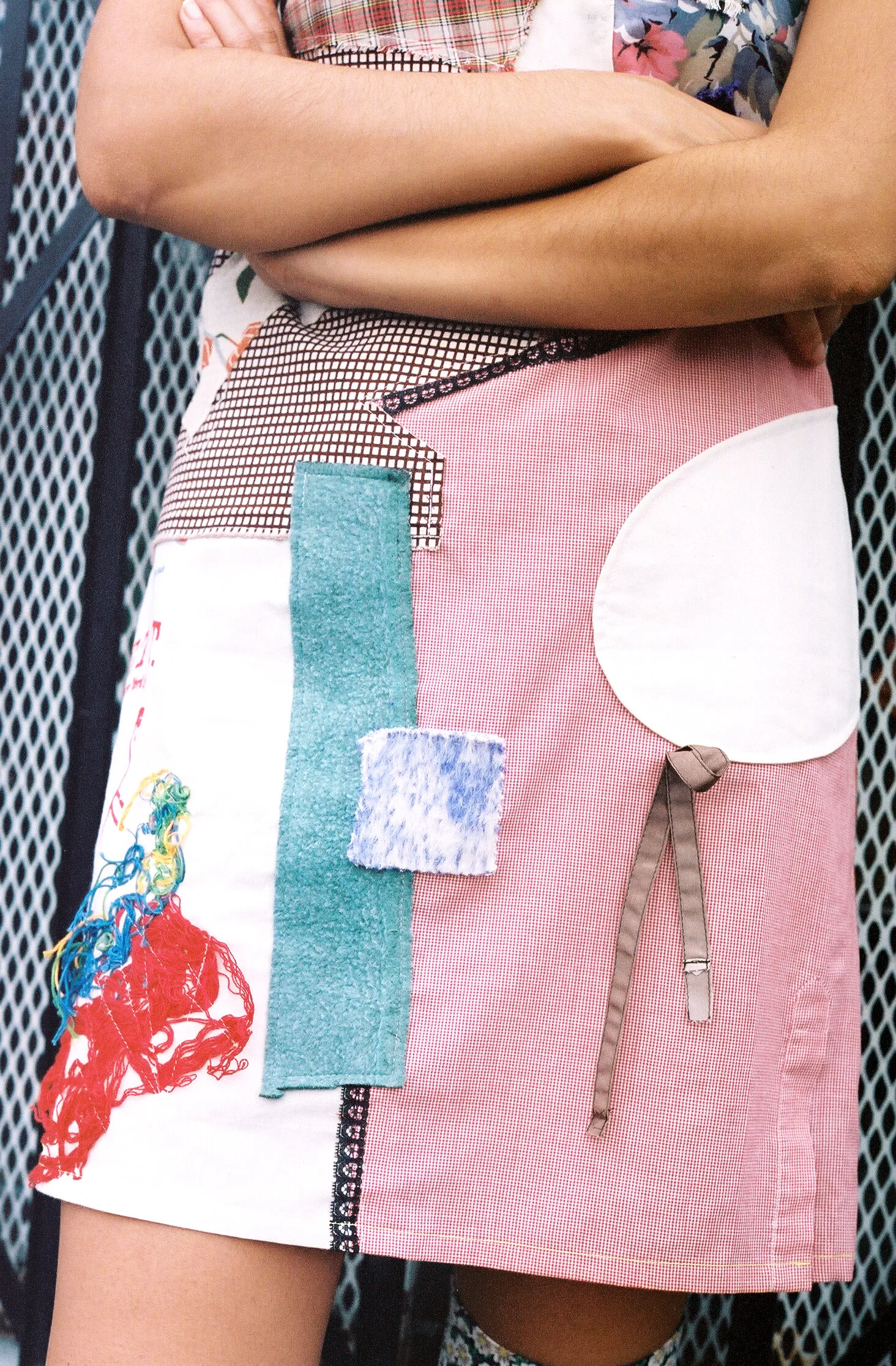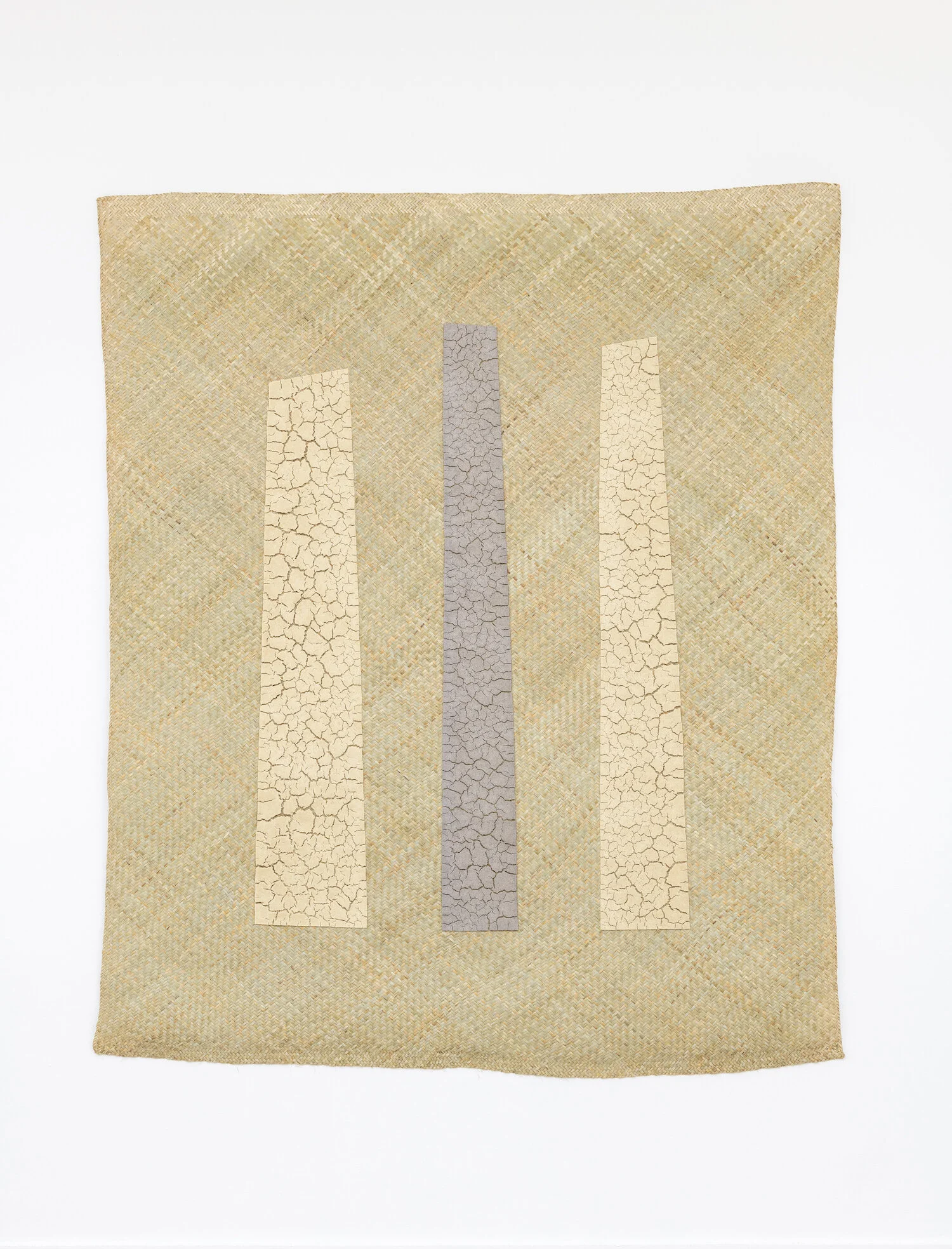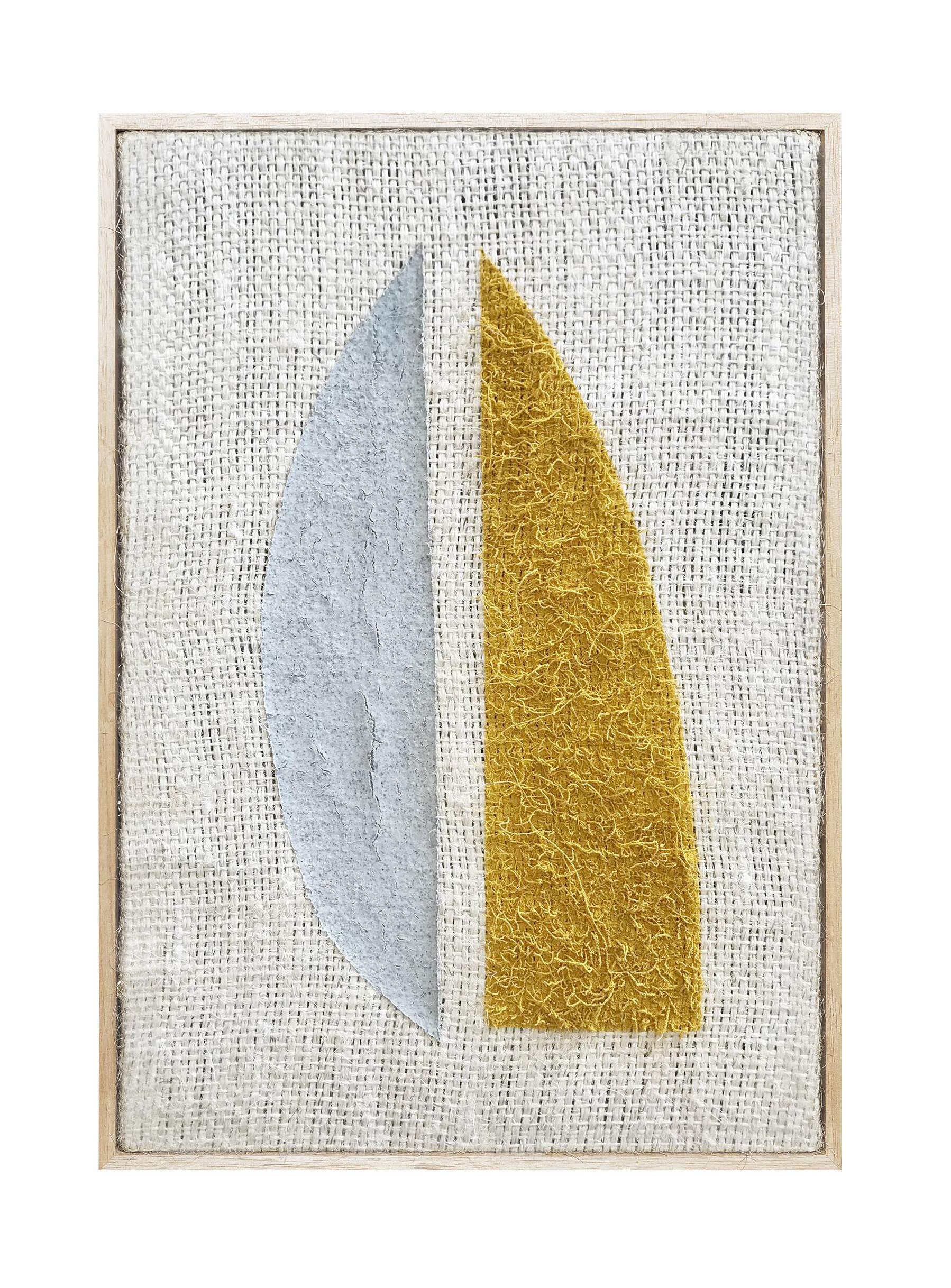Sustainable Studio Interview Series
With the undeniable presence of climate change, we’re asking ourselves how we can reduce environmental impact in our home lives. These creatives have taken the willingness to act consciously one step further by applying minimal-waste values to their studio practices. From scented paintings, to evocative collages, to shape-shifting wearables, these vastly different modes of expression prove that sustainable customs can be embraced in just about any artist’s workspace. I had the pleasure of interviewing this vibrant lineup who have collectively forged a deeper connection to both their work and the natural world as a result of going green.
-Kimberly Corday
Tashi Fay
Tashi Fay was born and raised in Los Angeles, CA, and currently lives in Brooklyn, NY. She received her BFA from the Rhode Island School of Design in 2014. Since then, she has worked independently as an artist and costume designer. In 2019 for her most recent exhibition, Tashi staged "thee belly walls" in the entire upstairs of the home at 15 Orient. "thee belly walls" explored the body as a vessel, shelter, and home through a series of tailored environments and inhabitants played by both dolls and human beings.
Statement
I am currently working between the media of collage, sculpture, painting and installation to create mini environments based on my dreams. I have always struggled with (and been inspired by) my insomnia, dreams/nightmares and sleep paralysis. I find through using my dreams as subject matter I can explore my everyday emotional states and most buried memories simultaneously with few limitations.
Film still from After the flood, 2020/2021. (In progress work)
Interview with Tashi Fay
Questions by Kimberly Corday
What prompted you to repurpose materials? Was it an environmental or artistic decision?
It definitely started as an artistic decision. I have always been drawn to old things. There’s something dark and magical about objects that used to belong to someone else, objects that have an unknowable past. Used clothing especially because it is one of the most intimate types of personal belongings both physically and emotionally.
I started collecting (hoarding) used clothing and magazines and books and oddities when I was pretty young. I remember the first time my aunt took me to the Fairfax flea market when I was 12 and marveling at the tables selling rusty old tweezers and scissors and coins and dirty dolls. I didn’t start regularly repurposing materials in my art until I was in college, and I was definitely influenced by looking at the work of artists like Louise Bourgeois and Wangechi Mutu, but once I realized how much I loved collage and assemblage it felt eerily providential that I had been unconsciously collecting random junk for years.
What is it about working with cast-off items that you enjoy the most?
I think it’s their potential for transformation. I love drawing and painting but I often feel more trapped and controlled when I try to execute the ideas I see in my head through those more boundless mediums. There is something about the constraint of transforming images and objects that already exist which makes me feel totally free.
I often will pick something up off the street because it already looks like something else to me- like the back of a chair that reminds me of a sad severed head and neck- and then it’s exciting to repackage it in a different context and make someone else also see it as a head and neck, and emotionally connect with that object as a character who has a story. I regularly incorporate images or objects into my work that are thematically related to the concept but end up hidden, disguised as something else and though their individual histories do add layers to the work I think the amalgamation is more important to me than the parts. I’m not someone who revels in “tricking” people or something but I do love to play with their suspension of disbelief.
Rummaging for materials can be a crucial part of the process...what are your gathering rituals?
I don’t know if I have any specific gathering ritual, but I do try to embrace the search process with an open mindset. I never know if I’m going to find what I’m looking for at a flea market or a thrift store or on the beach, so I have to be able to enjoy the wandering without too much of a focus on what I’ll carry home. Even if I have a specific material I’m looking for, it’s exciting to stumble across something even better for my intended purpose. And sometimes the yield is just pure inspiration, seeing something differently or studying the insides of an older object or piece of clothing to see how it was made or overhearing a strange conversation.
Who or what influenced your minimal-waste lifestyle?
I was heavily influenced by my experiences in the fashion industry and then the film industry. Just seeing the amount of discarded materials and empty plastic water bottles and no one seeming to care started to eat a bit at my brain. At one of my first fashion internships it was my job to “shred” old prototypes, to destroy lambskin dresses and big swatches of beautiful fabrics with scissors. I confess I saved a number of scraps to use for school projects...I felt especially disgusting shredding the leather pieces.
Do your green practices extend beyond the studio?
Yes. I am always trying to make choices with the least negative environmental impact in every area of my life, but it’s definitely a struggle and I am far from perfect. There are some changes in my lifestyle over the years that have come very easily to me like cooking vegetarian, using a diva cup, using toothpaste tablets, not buying plastic bags or wrap, carrying a reusable water bottle and bags, etc... And whenever I do need something I cannot buy secondhand I research companies using sustainable materials and practices and try to support them. But it’s hard to find a balance sometimes. Because even if I am trying to be conscious about my every move, I am not (thus far) the person making my own shampoo. I still buy plastic yogurt containers and fly in airplanes. I reuse my yogurt containers to hold natural turpenoid...
What are your supply store alternatives?
Goodwill, vintage stores and flea markets, my old clothes and things, my family’s old clothes and things, Etsy’s vintage selection, antiquefabric.com. I love searching for art materials on the street and on the beach. I love driftwood and shells and “clean” trash. I often look through my recycling bin. I convinced a nail salon once to donate all their old magazines to me... sometimes my friends just give me old clothes and magazines to use in my work.
Your collages make me think of Bosch’s paintings which touch on themes like depravity and gluttony...would you say your process is a way to reconcile or rebuke hyper- consumerism?
God I love Bosch and Bruegel so much. I am hugely influenced by both of them. I love movies and their works are very cinematic in my eyes. Everything is in motion, every character plays an important role and has their own agenda. And there is such comedy in the work. Humor is so important to me in art and in my personal work. I hate everything overly serious, which is funny because I can take myself too seriously...
My work is very character focused, and I am drawn to extreme characters and creatures and situations. I am definitely interested in our darker impulses to consume everything, and that comes through in my characters, and part of the comedy is in their extreme lack of self-awareness or gluttony or wastefulness or shamelessness or whatever, but I still view my characters as mostly sympathetic. I am very interested in psychology and exploring the peaks and depths of human nature within my characters and work in general, and through that of course I’m also exploring myself, but I try not to impose a set “morality” on my work. To me, morality is a very personal and murky subject. I try not to assume I am better than any of my characters and find reasons to love them and feel compassion for them in spite of XYZ.
Are there particular materials you’ve been wanting to work with?
I really want to learn how to make my own paper! And paints.
Cat Lauigan
Cat Lauigan is an interdisciplinary artist. She is also one half of collaborative duo BODYWORKBODYWORK and co-founder of CONE SHAPE TOP. Working with fibers, natural pigments, sculpture and sound, her body of work investigates the parallels drawn between self and nature through reductive processes in hopes of finding the essence of materials and objects as metaphors for personal histories. Such investigations are formalized and fragmented into textile forms, hand-made books and sonic collages. Expanding upon her fabric sculptures and natural dye practice is her playful eco wearable art collection. All pieces are one of a kind, made from recycled or repurposed materials and hand dyed with natural pigments. She lives and works in Oakland, CA.
From Lepitdoptera wearable series, 2020. Repurposed fabrics hand-dyed with eucalyptus leaves, indigo, madder root, avocado pits, turmeric, and fustic. Photograph by Richard Lomibao.
Interview with Cat Lauigan
Questions by Kimberly Corday
What is your relationship to nature in both your personal and creative life?
I always feel a gravitational pull towards water. It could be because I am a water sign but I often find myself thinking about its many different formations; rain, the ocean, streams, rivers, waterfalls. Other aspects I turn to are the earth for its grounding qualities, its slowness, its colors, textures, its cycles. Air / wind for its ephemeral qualities for its movement and sounds. It’s where I recharge and clear my head when I feel energetically stuck. It’s where I gain new perspectives and gather/source materials for making work. There is this desire to capture elements in nature and somehow translate them into tangible forms as a vessel of some sort of personal reflection through textile, flat works, soft sculpture or sound. Capturing aspects of nature and also weaving aspects that reflect who I am as a person.
How do you select fabrics to up-cycle? Does it come down to practicality or attraction?
Both. I have sourced and acquired a lot of textiles and fabrics over the years that I keep in a bin to recycle and reimagine for wearables or textiles pieces. Friends and family will give me old fabrics. I have also gone out to thrift shops, particularly the Goodwill sale bins, and if I find anything that appeals to me in texture or quality I’ll add it to my collection of materials.
Describe your studio setup. Are you a minimalist? A maximalist? Do you like to switch it up?
I work out of my home and since I work in so many different kinds of media, I have to configure my set up specifically for certain processes. If I’m in a dyeing period, then that set up remains for months until I feel finished with that particular process. I then clean up and reconfigure the space for whatever I am in the mood for next, whether it is sewing, paper making, making music, etc. I definitely would say I’m a maximalist, the more space I get, the more I tend to fill it up, usually with a lot of chaotic energy.
From Chrysalis Evening wearable series, 2020. Repurposed fabric hand-dyed with anatto seed, indigo, turmeric, pomegranate, madder root and logwood. Photograph by Richard Lomibao.
Is there a memento or talisman of sorts in your workspace that fuels your creative energy?
My mom recently gave me abaniko which is a hand-held style fan made from palm leaves in the Philippines. This particular one I have was made by an uncle of mine and hangs on a string right above my desk. With it I also have a sequined kimona (a traditional filipina top) given by my aunt. I have been thinking for a while on incorporating my culture into my work and find these family gifts as a way of blessing my workspace and to spiritually plant those seeds when they are ready to materialize.
What is your earliest memory of low-impact living?
We didn’t have a lot of money growing up so living a resourceful lifestyle was instilled very early on from my parents. My dad was an avid thrift shopper and enjoyed finding deals. He would always bring me and my sisters along and I grew to love it also. It definitely has shaped my habits surrounding consumerism, recycling and reusing.
In terms of thinking about sustainability in how my work is framed around it now, I would say that materialized around 2010 when I became more interested in traditional craft. I was living in the Outer Sunset of San Francisco at that time and discovered natural dyeing and was inspired from being around so much nature. I loved the idea of recycling food waste and leaves from fallen branches to create pigments. I began experimenting with red cabbage, onion skins left over from my fridge and eucalyptus leaves I would gather from my walks in the neighborhood.
I’m intrigued by the duality of your wearables. Off a body they’re relic-like objects...on a body they’re costumes with vastly different vitalities. Do you view these pieces as shapeshifters?
Absolutely, I think that’s definitely a tension I like to explore. Originally my interest had began in creating more soft sculptural layered wall pieces until a friend told me once she could see herself wearing a piece I had hanging on the wall. It was then that I became interested in exploring wearable art, especially after being inspired by artists like Helio Oiticica, Yukinori Maeda, Heidi Bucher, Susan Cianciolo — who played between those lines. I felt very much activated by that intersection. I am not formally trained in sewing or dyeing so everything I’ve done is with the spirit of experimentation and allowing intuition to guide each move, so the process in itself is also a form of shapeshifting. At this point now it has developed into my own technique. Depending on where I stop, a piece can be more object oriented and non-functional to wearable and functional. Like the artists I mentioned above, I really appreciate work that blurs those lines of form and function.
I understand trial-and-error is par of the course in natural dyeing...how does this affect your process?
I definitely embrace errors and would say that I allow space for it, as I don’t necessarily try to arrive to a specific result. I think in a lot of ways this stems from finding value in results that may not be perfect. Perhaps there’s a holistic value to that for me that somehow transmutes itself with my own self- acceptance, faults and all. Its funny because I tend to be a perfectionist on most things but this is the only outlet where I really let go of those tendencies, so there is also a lot of vulnerability that I tap into when I go into this headspace. When I first began dyeing, I was making fiber jewelry that was carried in retail spaces. This entailed a type of quality control that had to produce somewhat similar results. When I shifted my practice, I found myself leaning more towards the opposite and really enjoying the unpredictable outcomes. I felt very free and curious again. Since then I have really embraced the lack of control and it is actually what I love so much about natural dyeing, the range of results you can get from any single organic matter. A lot of the enjoyment also comes from getting to learn the properties of different flowers, plants, leaves, bark, fruit, vegetables, and minerals just through sheer curiosity and years of practice and gaining a basic understanding from trying different methods out. I have certain hues that I’m interested in achieving at times but its more about the surprise that is created by allowing fabrics to soak with any pigment over long periods of time and then working with that. I like to think of this process for me as being similar to a collaborative conversation with whatever I’m working with as opposed to having a desire to yield or control a certain color.
Is there a plant or material you hope to work with?
I had done a residency in Finland where I experimented a bit with foraged lichen and loved the ranges of chartreuse that came out as a result. Now that I’m back home in the Bay Area I would love to work more with local lichens. Also poke berries and Japanese maple leaves have been on my list.
For more, check out Cone Shape Top / BODYWORKBODYWORK or follow her on Instagram.
Kisa Sky Shiga of Strawberry Western
Strawberry Western is the anti-waste fashion project of Kisa Sky Shiga. With a DIY ethos, Strawberry Western knits together the global energy of Kisa’s hometown of Queens, NY with the traditions of craft and preservation of her Japanese and Irish heritage. In service of our planet and all living things, Strawberry Western’s duty is resourcefulness, crafting precious pieces out of unwanted old clothing, post-consumer waste and scraps. Many SW pieces are one-of-a-kind and handmade in the U.S.
Scrap patchwork flower petal bucket hat, knit muscle tee constructed from yarn made from secondhand t-shirts, leather scrap bin jeans, 2020. Photography: Yulia Zinshtein, Model: Paola Montepiedra.
Interview with Kisa Sky Shiga of Strawberry Western
Questions by Kimberly Corday
Your debut collection is comprised of one-of-a kind garments. Is the absence of multiples an environmental or artistic decision?
I would say it is equally an environmental and an artistic decision. So far the material, color and details of the clothing that I take apart or the scraps that I find fully inspire what the new piece will become. Once I use those materials up, I’m onto the next concept. Especially since I hand-make the one-of-a- kind pieces, there is more excitement in making something entirely new than in replicating another of something I’ve already made. I also believe people are more likely to cherish and take care of something that they know no one else has.
The meticulous handwork makes me think of multidisciplinary, fashion-craft artists like Susan Cianciolo. Do you consider your work cross-genre?
I think fashion is innately a multifaceted art form. There are so many things that inform and inspire the creation of what we wear that I’ve never thought of them as separate genres. When I am concepting a piece, I have to think about what combination of techniques can help bring the idea to life- knit, crochet, patchwork, embroidery, painting, dyeing, etc. But my work is always meant to be worn which probably keeps it in the realm of fashion.
When did you first consider your environmental impact? Did you inherit the eco-conscious gene?
It manifested in different ways throughout my life but I’ll just speak to the one that relates most to my work. My grandmother in Japan was a seamstress for many years and is the person who taught me how to sew and pattern-make as a kid. She was always making clothing, bags, little pincushions and dolls out of fabric scraps or old kimonos. She would often mail me boxes of vintage kimono fabrics or old kimonos she got from friends and neighbors to use for my own projects. I still have and use many of them and her resourcefulness has had a pretty apparent impact on the way I make things.
Your creative universe shares the spirit of 90s Japanese street style- specifically the youthful, cool-kid ensembles seen in early issues of FRUiTS Magazine. Can you speak a bit about how your cultural background has shaped your aesthetic?
I am half Japanese and growing up, my Dad and I used to go to Japan over my Summer vacations. We would fly into Tokyo from New York and spend a few days there before taking a train down to Himeji where my family is from. My Dad had brought me to Harajuku and going there became a tradition for us. As a kid, there was so much creative stimulation there. Massive shopping malls and tiny hole-in-the-wall stores with new, thrift and DIY things I had never seen before, craft department stores, arcades, incredible people/style-watching, Tower records... Looking back, those trips to Harajuku were really formative for me.
Your “Secret Message Sweater” made from deconstructed thrift-store knitwear took a year to complete. Are you patient by nature or was patience learned by way of these prolonged processes?
I would say I’m patient by nature when it comes to dealing with people, but much less so with myself and my work. Knitting is labor-intensive and there is no immediate gratification with it. You might be knitting for two weeks and then hold it up and realize it’s way too small and have to unravel and start over. As frustrating as those moments can be, knitting has become really meditative for me because it’s one of the only times I have alone with my thoughts. I have definitely learned to appreciate and enjoy the process through it.
What do you watch or listen to while in your workspace?
If I’m knitting, sometimes I can’t listen to anything because I need to count! For everything else, a few of my music staples of the past year were Rosalía, Andre Nickatina, Erika de Casier, Skepta, and The Smiths. I’ve also been listening to a bunch of audiobooks and podcasts. My favorite shows that I’ve gotten into are How to Save a Planet, The Business of Fashion Podcast and The Cutting Room Floor.
You’ve made an art out of avoiding excess consumption. What are some easy ways other artists can shrink their footprint?
Consider what you can make with the resources close to you; things you have at home, things you can find in your neighborhood or see what you can get from people you know. The trash/treasure saying really holds true. A lot of kind family and friends have given me a good portion of the materials that I have and have used thus far.
I love the idea of a garment having many lives. What is your hope for the work’s lifecycle over the course of, say, the next century? Would you rather they be passed down or remixed?
I always think about this. There is something so special about a garment being passed down whether it be through loved ones or through secondhand shops. I have these 25 year old leather pants that were my Dad’s when he was my age, among some other special t-shirts and jackets. I really feel like clothing holds memories and whether you got it from your grandmother or from Savers, there is a magic in your experiences adding onto the history of that piece. My hope is for these garments to be taken care of, passed around and repaired throughout the years.
For more, check out Kisa Sky Shiga’s fashion project Strawberry Western or follow her on Instagram.
Magda Skupinska
Magda Skupinska was born in Warsaw, Poland. She completed her BA in Fine Art at Central Saint Martins, London and her MA in Painting at the Royal College of Art, London. At the heart of Skupinska’s practice lies a conceptual and sensory dimension that investigates the tangible and fragile quality of organic materials. Her alluring use of natural and degradable materials such as spices and fruit, juxtaposed with traditional mediums, stimulate sensory experiences that encourage an engagement with the environmental issues caused by human activity. Her most recent solo exhibition at Maximillian William Gallery, London is a collection of works from her one year trip to Oaxaca, Mexico, where she collaborated with a group of indigenous females and local corn farmers.
Little Sunset I, 2018. Paprika and nopal on jute, 13.5” x 17.5”
Interview with Magda Skupinska
Questions by Kimberly Corday
Your titles and material descriptions conjure up visions of ancient craft traditions. Do you have particular studio rituals that hark back to age-old lifestyles?
It feels like my whole practice is somehow an age-old one. That’s one of the reasons why I love it so much. All the processes from the beginning to the end are hand crafted. I am sourcing all my materials from markets, farmers or crafts people, rather than art stores. I search for colors in nature instead of buying ready-made ones. I am mixing, grinding, drying, breaking, smelling the materials, trying to figure them out. And all that creates a sense of connection between me and the material, a deep sense of appreciation for what earth is giving us. I think that is something we have lost in our lives.
Everything is given to us packaged and ready, fast and easy. We are disconnected from the source of a product, its natural habitat, the way that people worked on it and with it, the processes it underwent, its history. My practice helps me bring back that missing piece.
Were earth-conscious customs passed down to you?
I was fortunate to be raised in a house where environmental awareness was taught to us from an early age. We lived next to a forest, so nature was just right there. It was a way of life, but I don’t think I took it as a subject in it self seriously enough until much later, when I moved to the city. I only then realized the grand scale of damage we are causing to this planet.
Do your green habits carry over into other areas of your life?
I try to do it as much as I can. Mainly in my daily life choices. It is a constant work in progress and something I believe we will have to work on and perfect for the rest of our lives.
When looking at your work, I’m reminded of the wiped out hunter-gatherer baskets crafted by prehistoric women and how the archeological record warped our early perceptions of gender roles (i.e. “men hunt, women look over the camp”). Do you see your art as gendered?
I would say no, I do not see my art as gendered. Although, I understand why people may view it that way. But I never take that avenue of thinking and it’s never something I consider while I am in the process of making. My fascination with nature, senses and natural material is what leads me through the process. It’s quite organic. My subject matter comes to me naturally. I engage with things that attract me, I follow my instinct. If you want to consider that a female instinct, that’s okay with me. But it’s not my position to define that. And more importantly, I don’t want to. I leave that for the viewer to decide.
It sounds like travel and cultural research are essential to your process. How much time do you devote to fieldwork versus making?
It depends, but fieldwork is definitely an important part of my working process. When I am traveling I aim to spend as much time as possible on exploration. I collect local materials, I go to nearby markets, I venture into beautiful locations. I try to learn about the place as much as possible - mostly through connecting with people and being in the land. Once I gather enough material, I take it to my studio and play with it. It is kind of like experimental cooking, I have many different, sometimes random, ingredients and I just try things out. I don’t have expectations, I just have ideas and test them out. This playful process allows me to explore the possibilities of the materials. Does it bend in an interesting way? Does it change color when I wet it? What is that smell? And that is when I start to build a relationship with material itself, and it leads me through the rest of the process.
Which region has had the greatest impact on your work?
The coast of Oaxaca. The region is structured very differently to highly industrialized areas I've been in contact with before. It consists of small, local communities where many of them specialize in different things like; clay production, corn farming, coconut fibre collecting or salt harvesting. It was the first time I could work so close to the sources of my materials. I was able to visit farmers, see the processes and the locations. I stayed there for over a year which gave me a lot of time to experiment and really get to know the place. Another thing that was very new to me was having my studio in tropics. Weather was interacting with my materials a lot, so I could try and test things out in a new way.
Where do you hope to visit next?
I’m really drawn towards India. Especially since it’s a home to so many spices. I’m looking forward to seeing their habitats of origin, the plantations and feeling the local cultures of the spices. I am also passionate about learning about their uses in healing practices.
How do you envision the work’s life cycle once it’s left the studio? Would each piece ideally be kept in a controlled environment for the sake of preservation or subject to decay like vegetable matter?
Each piece is made from a different material, and so each piece has a different process of transformation. But just to clarify, the surfaces of the paintings are always dry, therefore, the process of decay does not involve rotting, or, like you mentioned, something resembling a decaying vegetable. However, it is still an object made out of organic ingredients, and so it is in some way fragile and sensitive to the environment around it. The factors that may alter the appearance of the work are either temperature, or exposure to the UV light. And while shapes will never change, color or texture of the work may undergo a slight transformation. For example chili will lose its intense red color over time. These sort of changes are integral part of my work. We are here to observe them, not to control them. This is characteristic of natural matter that was once a living thing. Some works will transform faster and, for some paintings, we will have to wait a lifetime to see the change. This is the beauty of it.
With so much careful preparation, is it hard not to be precious with the organic materials?
I wouldn’t call it hard, at least not for me. I can see how it may be challenging for some but I find it to be the key part. Aren’t we obsessed with preserving things a little bit too much? W tend to be afraid of changes, we are scared of loosing things. We create so many attachments. My work is in some way a place to meditate on that. A place where there is a space for more appreciation for here and now and acceptance for the inevitable changes that time brings. There is a great beauty and sense of freedom in that.
Is there a particular plant you hope to bring into play?
I’m really looking forward to working with trees.
For more, check out Magda Skupinska’s website and Instagram.
Kimberly Corday
Kimberly Corday (b. 1992) is an artist based in Los Angeles, CA. Since receiving her BFA from Rhode Island School of Design where she studied Painting and Art History, she’s laid claim to an interdisciplinary territory that extends beyond the bounds of the canvas. Though her studio practice involves craft traditions, each piece harks back to a deep interest in classical painting.
For more, check out Kimberly Corday’s website here, or follow her on Instagram.

